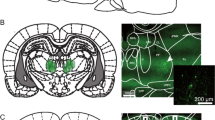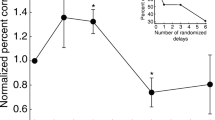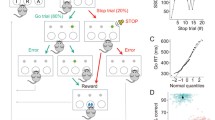Abstract
Rationale
Converging evidence implicates discrete areas of the rat prefrontal cortex in the modulation of different aspects of attention and executive control. Furthermore, the pharmacology of these behaviours has been relatively well characterised for the monoamine systems in a task of visuospatial attention, but it is not known how glutamate receptor antagonism in discrete regions of the prefrontal cortex affects attentional performance.
Objectives
To investigate the role of N-methyl-d-aspartate (NMDA) receptor antagonism in the prelimbic and infralimbic cortices (within the same animals) on performance of the five-choice serial reaction time task (5CSRTT), which assesses visuospatial attention and response inhibition.
Methods
Following training on the 5CSRTT, rats were implanted with bilateral guide cannulae aimed at the medial prefrontal cortex (mPFC). Rats received micro infusions of the competitive NMDA receptor antagonist 3-[(R)-2-carboxypiperazin-4-yl]-propyl-1-phosphonic acid [(R)-CPP; dissolved in saline to give 10 ng and 50 ng per side] into the prelimbic cortex, then three more infusions (saline, 10 ng and 50 ng per side) into the infralimbic cortex, in a counterbalanced design. They were then tested on a version of the task identical to that used in training.
Results
(R)-CPP microinfusions impaired accuracy and increased omissions across both cortical regions. (R)-CPP microinfusions robustly increased premature responding only when infused into the infralimbic, but not prelimbic, cortex.
Conclusions
These results indicate that NMDA receptor neurotransmission in the infralimbic cortex is necessary for control of impulsive responding on the 5CSRTT. These results suggest a dissociable role for prefronto-cortical glutamatergic systems in response inhibition, which appear to be functionally localised to the ventromedial infralimbic area of the mPFC.






Similar content being viewed by others
References
Aghajanian GK, Marek GJ (2000) Serotonin model of schizophrenia: emerging role of glutamate mechanisms. Brain Res Brain Res Rev 31:302–312
Birrell JM, Brown VJ (2000) Medial frontal cortex mediates perceptual attentional set-shifting in the rat. J Neurosci 20:4320–4324
Cardinal RN, Aitken MRF (2001) Whisker, version 2.2. http://www.whiskercontrol.com
Carli M, Robbins TW, Evenden JL, Everitt BJ (1983) Effects of lesions to ascending noradrenergic neurones on performance of a 5-choice serial reaction task in rats; implications for theories of dorsal noradrenergic bundle function based on selective attention and arousal. Behav Brain Res 9(3):361-380
Carli M, Baviera M, Invernizzi RW, Balducci C (2004) The serotonin 5-HT(2A) receptors antagonist M100907 prevents impairment in attentional performance by NMDA receptor blockade in the rat prefrontal cortex. Neuropsychopharmacology 29:1637–1647
Christakou A, Robbins TW, Everitt BJ (2001) Functional disconnection of a prefrontal cortical–dorsal striatal system disrupts choice reaction time performance: implications for attentional function. Behav Neurosci 115:812–825
Chudasama Y, Muir JL (2001) Visual attention in the rat: a role for the prelimbic cortex and thalamic nuclei? Behav Neurosci 115:417–428
Chudasama Y, Passetti F, Rhodes SE, Lopian D, Desai A, Robbins TW (2003) Dissociable aspects of performance on the 5-choice serial reaction time task following lesions of the dorsal anterior cingulate, infralimbic and orbitofrontal cortex in the rat: differential effects on selectivity, impulsivity and compulsivity. Behav Brain Res 146:105–119
Chudasama Y, Robbins TW (2004) Psychopharmacological approaches to modulating attention in the five-choice serial reaction time task: implications for schizophrenia. Psychopharmacology (Berl) 174:86–98
Cochran W, Cox G (1957) Experimental designs, 2nd edn. Wiley, New York
Dalley JW, Cardinal RN, Robbins TW (2004) Prefrontal executive and cognitive functions in rodents: neural and neurochemical substrates. Neurosci Biobehav Rev 28(7):771-784
Farber NB, Kim SH, Dikranian K, Jiang XP, Heinkel C (2002) Receptor mechanisms and circuitry underlying NMDA antagonist neurotoxicity. Mol Psychiatry 7:32–43
Goff DC, Coyle JT (2001) The emerging role of glutamate in the pathophysiology and treatment of schizophrenia. Am J Psychiatry 158:1367–1377
Goldman-Rakic PS, Muly EC III, Williams GV (2000) D(1) receptors in prefrontal cells and circuits. Brain Res Brain Res Rev 31:295–301
Granon S, Passetti F, Thomas KL, Dalley JW, Everitt BJ, Robbins TW (2000) Enhanced and impaired attentional performance after infusion of D1 dopaminergic receptor agents into rat prefrontal cortex. J Neurosci 20:1208–1215
Higgins GA, Ballard TM, Huwyler J, Kemp JA, Gill R (2003a) Evaluation of the NR2B-selective NMDA receptor antagonist Ro 63-1908 on rodent behaviour: evidence for an involvement of NR2B NMDA receptors in response inhibition. Neuropharmacology 44:324–341
Higgins GA, Enderlin M, Haman M, Fletcher PJ (2003b) The 5-HT(2A) receptor antagonist M100,907 attenuates motor and ‘impulsive-type’ behaviours produced by NMDA receptor antagonism. Psychopharmacology (Berl) 170:309–319
Howell D (1997) Statistical methods for psychology, 4th edn. Wadsworth, Belmont, CA
Huynh H, Feldt L (1970) Conditions under which mean square ratios in repeated-measures designs have exact F-statistic distributions. J Am Stat Assoc 65:1582–1589
Jentsch JD, Redmond DE Jr, Elsworth JD, Taylor JR, Youngren KD, Roth RH (1997a) Enduring cognitive deficits and cortical dopamine dysfunction in monkeys after long-term administration of phencyclidine. Science 277:953–955
Jentsch JD, Tran A, Le D, Youngren KD, Roth RH (1997b) Subchronic phencyclidine administration reduces mesoprefrontal dopamine utilization and impairs prefrontal cortical-dependent cognition in the rat. Neuropsychopharmacology 17:92–99
Kolb B (1990) Prefrontal cortex. In: Kolb B, Tees R (eds) The cerebral cortex of the rat. MIT, Cambridge, MA, pp 437–458
Konradi C, Heckers S (2003) Molecular aspects of glutamate dysregulation: implications for schizophrenia and its treatment. Pharmacol Ther 97:153–179
Krystal JH, D’Souza DC, Mathalon D, Perry E, Belger A, Hoffman R (2003) NMDA receptor antagonist effects, cortical glutamatergic function, and schizophrenia: toward a paradigm shift in medication development. Psychopharmacology (Berl) 169:215–233
Kurtz MM, Ragland JD, Bilker W, Gur RC, Gur RE (2001) Comparison of the continuous performance test with and without working memory demands in healthy controls and patients with schizophrenia. Schizophr Res 48:307–316
Lahti AC, Weiler MA, Tamara Michaelidis BA, Parwani A, Tamminga CA (2001) Effects of ketamine in normal and schizophrenic volunteers. Neuropsychopharmacology 25:455–467
Laruelle M, Kegeles LS, Abi-Dargham A (2003) Glutamate, dopamine, and schizophrenia: from pathophysiology to treatment. Ann N Y Acad Sci 1003:138–158
Leveque J-C, Macias W, Rajadhyaksha A, Carlson R, Barczak A, Kang S, Li X-M, Huganir R, Heckers S, Konradi C (2000) Intracellular modulation of NMDA receptor function by antipsychotic drugs. J Neurosci 20:4011–4020
Low SJ, Roland CL (2004) Review of NMDA antagonist-induced neurotoxicity and implications for clinical development. Int J Clin Pharmacol Ther 42:1–14
Mauchly J (1940) Significance test of sphericity of a normal n-variate distribution. Ann Math Stat 11:204–209
Moghaddam B, Adams B, Verma A, Daly D (1997) Activation of glutamatergic neurotransmission by ketamine: a novel step in the pathway from NMDA receptor blockade to dopaminergic and cognitive disruptions associated with the prefrontal cortex. J Neurosci 17:2921–2927
Murphy ER, Baxter MG, Rodefer JS (2003) The effect of PDE10A inhibition on frontal cognitive performance in a subchronic phencyclidine model of schizophrenia. 448.2. Society for Neuroscience 33rd Annual Meeting, New Orleans, LA
Orzack MH, Kornetsky C (1966) Attention dysfunction in chronic schizophrenia. Arch Gen Psychiatry 14:323–326
Passetti F, Chudasama Y, Robbins TW (2002) The frontal cortex of the rat and visual attentional performance: dissociable functions of distinct medial prefrontal subregions. Cereb Cortex 12:1254–1268
Paxinos G, Watson C (1998) The rat brain in stereotaxic coordinates, 4th edn. Academic, New York
Pei L, Lee FJ, Moszczynska A, Vukusic B, Liu F (2004) Regulation of dopamine D1 receptor function by physical interaction with the NMDA receptors. J Neurosci 24:1149–1158
Ragozzino ME, Detrick S, Kesner RP (1999) Involvement of the prelimbic–infralimbic areas of the rodent prefrontal cortex in behavioral flexibility for place and response learning. J Neurosci 19:4585–4594
Reid L, Egerton A, Morris B, Pratt J (2003) Acute PCP administration produces an attentional set shifting deficit and reduced neural activity in the medial frontal cortex of the rat. 940.11. Society for Neuroscience, 33rd Annual Meeting, New Orleans, LA
Robbins TW (2002) The 5-choice serial reaction time task: behavioural pharmacology and functional neurochemistry. Psychopharmacology (Berl) 163:362–380
Rogers RD, Baunez C, Everitt BJ, Robbins TW (2001) Lesions of the medial and lateral striatum in the rat produce differential deficits in attentional performance. Behav Neurosci 115:799–811
Seamans JK, Floresco SB, Phillips AG (1995) Functional differences between the prelimbic and anterior cingulate regions of the rat prefrontal cortex. Behav Neurosci 109:1063–1073
Stefani MR, Moghaddam B (2002) Effects of repeated treatment with amphetamine or phencyclidine on working memory in the rat. Behav Brain Res 134:267–274
Stefani MR, Groth K, Moghaddam B (2003) Glutamate receptors in the rat medial prefrontal cortex regulate set-shifting ability. Behav Neurosci 117:728–737
Stefani MR, Moghaddam B (2003) Distinct contributions of glutamate receptor subtypes to cognitive set-shifting abilities in the rat. Ann N Y Acad Sci 1003:464–467
Tamminga CA (1998) Schizophrenia and glutamatergic transmission. Crit Rev Neurobiol 12:21–36
Tseng KY, O’Donnell P (2003) Dopamine–glutamate interactions in the control of cell excitability in medial prefrontal cortical pyramidal neurons from adult rats. Ann N Y Acad Sci 1003:476–478
Verma A, Moghaddam B (1996) NMDA receptor antagonists impair prefrontal cortex function as assessed via spatial delayed alternation performance in rats: modulation by dopamine. J Neurosci 16:373–379
Vertes RP (2004) Differential projections of the infralimbic and prelimbic cortex in the rat. Synapse 51(1):32-58
Winstanley CA, Chudasama Y, Dalley JW, Theobald DE, Glennon JC, Robbins TW (2003) Intra-prefrontal 8-OH-DPAT and M100907 improve visuospatial attention and decrease impulsivity on the five-choice serial reaction time task in rats. Psychopharmacology (Berl) 167:304–314
Zajaczkowski W, Hetman M, Nikolaev E, Quack G, Danysz W, Kaczmarek L (2000) Behavioural evaluation of long-term neurotoxic effects of NMDA receptor antagonists. Neurotox Res 1:299–310
Zilles K (1990) Anatomy of the neocortex: cytoarchitecture and myleoarchitecture. In: Kolb B, Tees R (eds) The cerebral cortex of the rat. MIT, Cambridge, MA, pp 77–112
Acknowledgements
The authors wish to thank Kristjan Lääne, Kim Hellemans, Mercedes Arroyo and David Theobald for technical assistance, and Rudolf Cardinal for statistical assistance and comments on the manuscript.
This work was supported by a Wellcome Trust Programme grant and completed within the MRC Centre for Behavioural and Clinical Neuroscience. E.R.M. was supported by a Gates Cambridge Scholarship.
Author information
Authors and Affiliations
Corresponding author
Rights and permissions
About this article
Cite this article
Murphy, E.R., Dalley, J.W. & Robbins, T.W. Local glutamate receptor antagonism in the rat prefrontal cortex disrupts response inhibition in a visuospatial attentional task. Psychopharmacology 179, 99–107 (2005). https://doi.org/10.1007/s00213-004-2068-3
Received:
Accepted:
Published:
Issue Date:
DOI: https://doi.org/10.1007/s00213-004-2068-3




